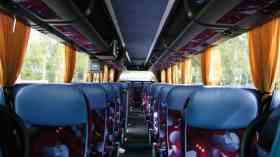The challenge of winter maintenance
 From the campus environment of a university, college, or larger independent school, to the grounds of a single site ‘maintained’ primary or secondary school, it is no surprise that most maintenance problems arise during the winter season. In place of coping with grass cutting and shrub bed maintenance schedules throughout the spring and summer months, estates bursars and caretakers find themselves planning winter maintenance regimes that focus on keeping the establishment running and reducing to an absolute minimum the risk of injury to those staff and students it serves.
From the campus environment of a university, college, or larger independent school, to the grounds of a single site ‘maintained’ primary or secondary school, it is no surprise that most maintenance problems arise during the winter season. In place of coping with grass cutting and shrub bed maintenance schedules throughout the spring and summer months, estates bursars and caretakers find themselves planning winter maintenance regimes that focus on keeping the establishment running and reducing to an absolute minimum the risk of injury to those staff and students it serves.
Sports pitches and safety surfaces
Maintaining grass sports pitches to provide a playable surface for as long as possible throughout the winter months is no mean feat. A regular maintenance regime throughout the year, including verti-draining and spiking to reduce compaction, will help to improve drainage and reduce winter ‘puddling’.
Creating a healthy sward will also reduce the risk of impact injuries and abrasions from falls on sparse turf and compacted ground. Verti-draining requires specialist equipment, which is attached to a tractor, with tines that are up to one inch in diameter. These are thrust into the pitch surface, heaved slightly, and pulled out, loosening the compacted soil. A sand dressing is generally applied and areas where the grass is particularly sparse, e.g. goal mouths, are seeded. As grass on winter pitches is generally left longer for safety purposes, ‘cutting in’ of the grass is usually required to ensure pitch markings remain visible throughout the winter.
In addition to grass pitches, many centres of education have all-weather pitches. To prevent the playing surface becoming ‘clogged’ with ice, moss, algae and other detritus during the winter months, regular weekly drag brushing is essential. This will keep the surface aerated, re-distribute the infill material supporting the ‘turf’ fibres, and maintain a safe playing surface.
A comprehensive maintenance regime is provided by specialist contractors with equipment designed for the job. Pushing a stiff broom around once a week is not adequate maintenance in situations where the safety of users is paramount.
Any safety surfacing beneath play equipment must comply with BS EN 1176(2008) and tested to BS EN 7188 (1998+A2 2009); Part 7 of BS EN 1176(2008) covers maintenance of these surfaces. Safety surfaces include wet‑pour surfacing, loose fill impact absorbing surface (LIAS), grass safety matting, artificial grass/carpet surfacing, bonded rubber or composite systems, and rubber tiles. In the majority of the above cases, a stiff broom used weekly to remove leaf fall, mud etc, and to prevent the build-up of moss and algae, will be sufficient.
The dangers of trip hazards must always be considered, whatever the time of year, but the greatest danger in the winter months is from slipping on surfaces that have become dirty and slippery. It is also worth remembering that in very cold temperatures, contact with metal can bring its own discomforts, particularly for young children, so playing on slides and other metal equipment in the playground during the colder winter months should be adequately risk assessed.
Snow and ice planning
A severe winter can create many difficulties for schools, colleges and universities. In a campus environment there are footpaths and thoroughfares with heavy use at particular times of the day and the requirement to keep these thoroughfares open and safe is paramount. Careful planning and taking preventative measures can go a long way to successfully negotiating the winter months.
Monitoring of weather reports to identify when to grit is essential. Rather than rely on the general overview of a regional radio station a more reliable option is the Met Office’s OpenRoad service (www.metoffice.gov.uk/roads/openroad). Depending on the level of service to which an organisation subscribes, it will provide regular pdf updates, sent to a phone if required, showing forecast data for RST (road surface temperature – much more relevant than air temperature when deciding when to grit), rainfall, falling snow and road state. It also uses a traffic light system to help users make informed judgements on gritting and premises closure; knowing when to grit footpaths and roads, especially on large campuses, can reduce the annual cost of gritting materials and the labour to apply it (usually comprising overtime for unsociable hours) considerably. Additionally, in the increasingly litigious society in which we must all operate, where errors of judgement in deciding whether or not to grit can result in accident and injury, it is worth being able to support decisions made by bursary/caretaking staff by referring back to the official scientific data on which the original decision was based.
The environment
Also to be considered is the environmental impact of using gritting materials such as halite, commonly called rock salt. As the name indicates, this is the mineral form of sodium chloride (NaCl) and whilst it is effective in helping to melt ice and snow (brine has a lower freezing point than pure water), its over use can affect grass and plants adjacent to paths and roads with which it comes into contact.
The danger from icy paths and roads can be exacerbated by the failure to maintain gutters and drains. If autumn leaf fall and roof detritus is allowed to accumulate in gutters, the rainfall from late autumn storms can cause them to overflow and drains to become blocked. All that is then needed for affected paths to become treacherous is a hard frost. The Work at Height Regulations 2005 requires that the risks from work at height are assessed and appropriate work equipment is selected and used. Gutter clearance may not always be achievable safely by two men and a ladder and the use of an elevated work platform, or ‘cherry-picker’ may be a safer, if more costly, option. Nevertheless, by carrying out this preventative work as soon as the bulk of the leaves have fallen, another potential slip hazard on the school estate is removed.
Where there are open areas of water that are likely to freeze, reasonable precautions should be taken to prevent any ill-judged attempts to ‘test the ice’. Additionally, if access around/over watercourses is available, e.g. boardwalks, bridges etc, these should be kept free of algae, moss or plant matter and sand put down to prevent slipping in frosty conditions. In periods of snow it may be advisable to limit access or prohibit it entirely.
Trees
Winter snowfall can put considerable extra strain on the limbs of mature trees, particularly if autumn storms have put those limbs under pressure. Regular tree surveys should be part of every educational establishment’s maintenance regime. Trees can kill, and without notice if you are not monitoring their health and status. If you have a large estate and numerous trees, engage a qualified arboricultural contractor to establish a tree maintenance plan, which will begin with a detailed survey of mature trees (i.e. over and above a certain size) that have the potential to cause damage should their health and physical integrity deteriorate. Trees are currently under considerable threat from numerous pests and diseases and the outward physical signs are not always apparent to the untrained eye.
There is no excuse for failing to have your trees regularly assessed so that preventative tree surgery work can be carried out if required.
Maintaining any grounds is a challenge in the winter months, particularly where pedestrian access and usage takes priority over vehicles. The potential for injury from falls is heightened and the implications of fault being found with the school/college/university for failure to take proper precautions to prevent accidents need no explanation.
Outside help
Few schools are likely to have their own snowplough for periods of heavy snow, or their own gritters. Neither are they likely to have equipment such as a cherry picker to access gutters and flat roofs. If they do not use the services of a professional grounds maintenance company they will be largely left to deal with extreme weather events as best they can. However, this may not be the wisest course of action, particularly for independent schools that have no recourse to local authorities to help them keep their schools open.
If in-house bursary/caretaking staff are not suitably resourced with the necessary plant and equipment, an annual grounds maintenance contract with a reputable, accredited grounds maintenance company is an attractive option. There are BALI Registered contractors around the country, for example, that can provide the full range of services, from sports pitch maintenance, verti-draining, tree surgery, gritting and snow clearance, gutter clearance, shrub bed maintenance, grass cutting, playground inspection and maintenance, and the plethora of activities that estate bursars must deal with throughout the course of the year. They will subscribe to the Met Office OpenRoad service and know exactly when to grit paths and roads and will take the burden of estate safety, particularly during the winter months, from the shoulders of the Estates Bursar or caretaker.
Further information
www.bali.org.uk
Latest News
31/10/2025 - 10:12
A growing number of UK children are now eligible for Free School Meals (FSM), yet most still aren’t taking advantage of them on a daily basis, new research reveals.
30/10/2025 - 01:28
In the wake of the Raac crisis, the DfE spent £5 million on research into the condition of school buildings, which is due to conclude in spring 2026.
30/10/2025 - 01:09
Malmesbury Primary School in Wiltshire has submitted plans for a major expansion, funded by entrepreneur James Dyson.
30/10/2025 - 00:55
Monday's Every Pair Tells a Story campaign to protest to highlight the national crisis in SEND provision.
29/10/2025 - 09:19
Estimated data from the Department for Education reveals that 470,000 pupils under 16s use local authority funded transport to get to school.







